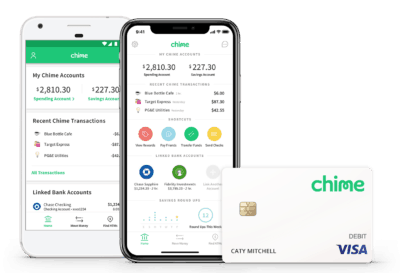Chime

Product Name: Chime
Product Description: Chime is a financial technology company that offers banking services through banking partners. They have a checking account with a Chime Visa Debit Card, an optional savings account, and the ability to get your paycheck 2 days early. They also offer a credit builder credit card.
Summary
Chime was founded in 2012 in San Francisco, CA and gets banking services through a partnership with The Bancorp Bank and Stride Bank, N.A.
Overall
Pros
- Automatic rounded up savings transfers
- No fees
- Fee-free overdraft up to $200
- No minimum balance
- 60,000+ fee-free ATMs
Cons
- Financial technology company

What if I told you there was an award winning mobile checking account and debit card that combines the features of a high yield online savings account with the automatic savings of a micro-savings app?
That’s Chime. If you were building an account from the ground up, these are the features people care about.
Chime is a financial technology company, not a bank. Banking services provided by The Bancorp Bank, N.A. or Stride Bank, N.A., Members FDIC. The Chime Visa® Debit Card is issued by The Bancorp Bank or Stride Bank pursuant to a license from Visa U.S.A. Inc. and may be used everywhere Visa debit cards are accepted. Please see back of your Card for its issuing bank.
Table of Contents
Who is Chime?
Before we get ahead of ourselves, let’s get the basics out of the way first.
Chime white-labels the banking services of The Bancorp Bank and Stride Bank, N.A., Bancorp is the same company that runs the banking services for a litany of private label banks. The Bancorp Bank is FDIC #35444 and has been actively insured by the FDIC since July 2000.
By “white-label” what I mean is that all the legal aspects of running a bank are handled by Bancorp Bank (NASDAQ: TBBK), Chime layers their services, their app, etc. on top of what Bancorp Bank offers. While it uses the banking services of The Bancorp Bank, Chime builds its features and perks on top of the engine they provide.
The Bancorp Bank powers 100+ private-label non-bank partners and processes $232 billion annually. They’re a publicly-traded company and you’ve probably never heard of them because they run behind the scenes of other banks. They’ve been around since 1999, are FDIC insured, but have zero branches. They’re entirely private label.
What does Chime offer?

Chime offers a checking account and an optional savings account, as well as a Chime Visa® Debit Card. A Chime Checking Account is required to be eligible for a Savings Account. There are no monthly minimum balance requirements, no monthly fees, and fee-free overdraft up to $2001, as well as a fee-free ATM2 network that includes over 60,000 locations.
When they first launched, the Savings Account didn’t offer much in terms of interest but that has changed. As of July 2022, the annual percentage yield on the Chime Savings Account is 2.00% APY.3
One other nice feature – early access to your paycheck. Some banks hold it a couple of days, for “processing,” but with Chime, when you set up a direct deposit, you can get your paycheck 2 days early.4
If you enable the Automatic Savings features, they round up every debit card transaction and transfer that money from your Checking Account into your Savings Account.5 You can also enable automatic transfers of 10% of every paycheck into your Savings Account.5
Finally, if you’re looking to build credit history, the Secured Chime Credit Builder Visa® Credit Card is an option for those who have received a qualifying direct deposit to their Checking Account6 and want or need to build up their credit history.
Chime offers a mobile check deposits feature that you can unlock if you have direct deposit setup via their app.7 All other banking features you’d expect are in there (including bill pay electronically as well as the mailing of a check since they don’t provide checkbooks to their members).
Pros and Cons
Chime used to offer $5 to open an account but no more, it’s not as nice of an incentive anyway compared to the hundreds of dollars some banks will give you. Getting your paycheck up to two days early4 with direct deposit and fee-free overdrafts up to $2001 are good perks.
They also don’t offer some familiar deposit products like Certificates of Deposit or loan products like a mortgage or car loans. No biggie though.
They have a network of 60,000+ fee-free ATMs2 that you can use… but go outside of it and you may be charged an out-of-network ATM withdrawal fee.
Who is Chime for?
If you want a simple, straight-forward account with automatic savings, no account fees, and a debit card – Chime does this.
They get good marks on their app and their user experience.
Considering they don’t charge you monthly fees, they’re an attractive option if you like automatic savings but don’t want to pay $5/mo to the likes of Digit (depending on how much you save, you could be surrendering that in interest).
Chime Alternatives
Once you take away the rewards, Chime becomes an online checking account that deposits your paycheck up to two days earlier4 with direct deposit.
If I needed to pick a primary checking account, I’d rather open an account at Ally Bank, get 3.80% APY on my savings account, and just get my paycheck as normal. Ally Bank has no minimums, no maintenance fees, and has an app that lets you do everything you need (like deposit checks through the mobile app).
If you really want a microsavings app, you could give Acorns a try. They play more on the investing side and they have fees, but they’re worth a look.
Here are a few other alternatives to Chime in case those don’t attract you.
Disclosures:
1 Chime SpotMe is an optional, no fee service that requires a single deposit of $200 or more in qualifying direct deposits to the Chime Checking Account each month. All qualifying members will be allowed to overdraw their account up to $20 on debit card purchases and cash withdrawals initially, but may be later eligible for a higher limit of up to $200 or more based on member’s Chime Account history, direct deposit frequency and amount, spending activity and other risk-based factors. Your limit will be displayed to you within the Chime mobile app. You will receive notice of any changes to your limit. Your limit may change at any time, at Chime’s discretion. Although there are no overdraft fees, there may be out-of-network or third party fees associated with ATM transactions. SpotMe won’t cover non-debit card transactions, including ACH transfers, Pay Friends transfers, or Chime Checkbook transactions. See Terms and Conditions.
2 Out-of-network ATM withdrawal fees may apply except at MoneyPass ATMs in a 7-Eleven, or any Allpoint or Visa Plus Alliance ATM.
3The Annual Percentage Yield (“APY”) for the Chime Savings Account is variable and may change at any time. The disclosed APY is effective as of <date w/in 3 months>. No minimum balance required. Must have $0.01 in savings to earn interest.
4Early access to direct deposit funds depends on the timing of the submission of the payment file from the payer. We generally make these funds available on the day the payment file is received, which may be up to 2 days earlier than the scheduled payment date.
5Round Ups automatically round up debit card purchases to the nearest dollar and transfers the round up from your Chime Checking Account to into your savings account. Save When I Get Paid automatically transfers 10% of your direct deposits of $500 or more from your Checking Account into your savings account.
6To be eligible to apply for Credit Builder, you need to have received a qualifying direct deposit of $200 or more to your Checking Account within 365 days of your Credit Builder application. The qualifying direct deposit must have been made by your employer, payroll provider, or benefits payer by Automated Clearing House (ACH) deposit. Bank ACH transfers, Pay Friends transfers, verification or trial deposits from financial institutions, peer to peer transfers from services such as PayPal, Cash App, or Venmo, mobile check deposits, and cash loads or deposits are not qualifying direct deposits.
7Mobile Check Deposit eligibility is determined by Chime in its sole discretion and may be granted based on various factors including, but not limited to, a member’s direct deposit enrollment status.




You can now use the Chime banking app to deposit checks. I opened my account in January 2018, and this feature has been there from the beginning.
I have had nothing but a great experience with Chime. I especially like the “Spot Me” as Chime lets you over withdraw an amount for no bank penalty fees. For instance, a trip to the gas station while waiting for pay day or dog\ cat food. You can refer friends and family to receive $50 per person as well. You and your friend get rewarded. Also, I love that I get paid two days early. I highly recommend Chime!
I really like banking with Chime, but the app on my phone has changed and I don’t like it. I use to go to my app put in my pin and “Bam” therecwas my account balance and record of my transactions. Now all I have is how I can get my check’s deposited 2 days early. What’s the deal.?
You have to enroll in Direct Deposit in order to use The Mobile Check Deposit Feature.
Iv had a few small issues with chime but on one accession I had my account hit w a unauthorized charge and cleand my account out I was notified to this when I was making a purchase at a gas station when the attendant announced to the whole store that my care was NFC and then went ahead and told me the balance to my account and I checked my phone and sure enough she was correct about the amount I called both Chime and the as station. And neither would acknolage that their systems would be able to do… Read more »
I am enrolled in direct deposit.
I have used chime over a year and at first completely love the card until it was compromised and now it has been over month and still havent received a new card.Not only is it impossible to talk to an actually human it is impossible to even get my card when I ask about why I havent got it all they can do to help is send another card which they say can not be express shipped so here I am having to wait another 2 weeks…..very unhappy!!!!!
Yup. My account was closed due to unauthorized transactions that they found an error and supposably credited my account after they closed it over a week ago. One day before my direct deposit went in which I still yet too receive my funds and my employer can’t re issue another check till the funds have been released. I’ve emailed them numerous times and no response what Soo ever and it’s impossible too contact them unless u have an open account. I’m bout too contact an Attourney tho cuz by law they have only 5 days too return my check back.… Read more »
Yes, I recently opened a Chime account. I set my direct deposit up. Got the notification of the deposit went to get some groceries it was denied, they closed my account as soon as they received my paycheck. I am clueless why never use this card. They how have two of my paychecks and I can’t pay my rent. They are saying 30 days to receive my check if your account gets closed for any reason no one will talk to you. I want to spread this warning I’m pissed.
It sounded great at the beginning, no fees, ATMs anywhere, hassle free. Sounds good until you have an actual problem. Then, good luck getting even 1/10th the customer service a normal bank provides. My card was stolen. in a period of 4 hours my entire checking account, over $3,000 was drained. My statement reads like a text book fraud case, 21 transactions all in the $100-200 range. Basically they were at three Walmarts and appeared minutes or less apart. Now, any normal bank would surely have stopped this incredibly odd behavior after 2, maybe 3 of these transactions. But not… Read more »
Yikes this is a harrowing story – I hope you can get it sorted out!
You can simply turn your card off with the app of it’s stolen. One swipe and you could have saved yourself a world of trouble.😉
Worst bank I have ever used in my entire 40 years of doing business with a bank. I have also been in the financial services industry for 20 years so I know quite a bit about what can and can’t be done and what the banking laws are. I tried to deposit a check for $1500 into my chime account using the mobile app. It said the check was approved and the funds would be available the following business day. It was imperative I have those funds by August 2nd, Friday, the day they said the funds would be available.… Read more »
Actual Chime customer/user reviews are the best and tell the real story here … I want a bank that will be there for me if there is a problem, when someone is messing with your money it’s not funny. Based on all of the negative user reviews that Chime has managed to receive from actual Chime customers, does not look like the kind of place I want to keep any of my money.
You stated there is no cash back feature, that is not true. I get cash back all the time.
They may look good on the surface, but do not use Chime! Read the stories of actual customers and the numerous complaints made. I opened an account about 6 mos ago. I had direct deposit run through them. On Monday I received another direct deposit and on Tuesday Chime closed my account, without notification, and left me with zero access to my funds. After numerous phone calls and emails, I still have not received an answer as to how to receive my funds back. Chime tells me it is in Bancorp’s hands and Bancorp tells me it is in Chime’s… Read more »
What a mess! First, their site to make an online application was down for several days. Finally I was able to. After going back to make a minor correction before submitting, it in fact it did submit my Application. It was declined w/o explanation. Subsequent attempts to start over were immediately declined. After 40 successful years of banking and investing, I’ve never encountered such an untenable situation.
My sage advice – stay away at all costs!
I see many negative comments about Chime. I believe Chime is a scam. I have a chime card but don’t want to use it. I use Capital One 360 checking. Is great. I don’t have problem with it.
Chime is not a scam LOL. It’s an awesome card. I usually get my direct deposit 3 to 4 days early.
Chime don’t not have your back and chime doesn’t care if someone makes a transaction without your consent CHIME WILL NOT. Look into it and will not refund your money i wouldn’t give them suckas the last Star in the sky if they needed it so DON’T bank with them
I have never had to use there support. Never had a problem at all. Best card. Best service.
Con- No other way to deposit check other then online. First month can only deposit
check under $500 and limited to $500 that month.
I have a check that is from a municipal retirement fund that they will not deposit in my account. They say the check is in an unrecognizable format. Yet it has a web address and a phone number to call. Lots of hoops to jump through with Chime.
The new minimum is $1000 now.
I am not sure about this. I recently signed up, but I noticed after I deposited 100.00, that, even after using my card, that amount didn’t go down. I am spoiled, my transactions always showed at my bank. I am disappointed